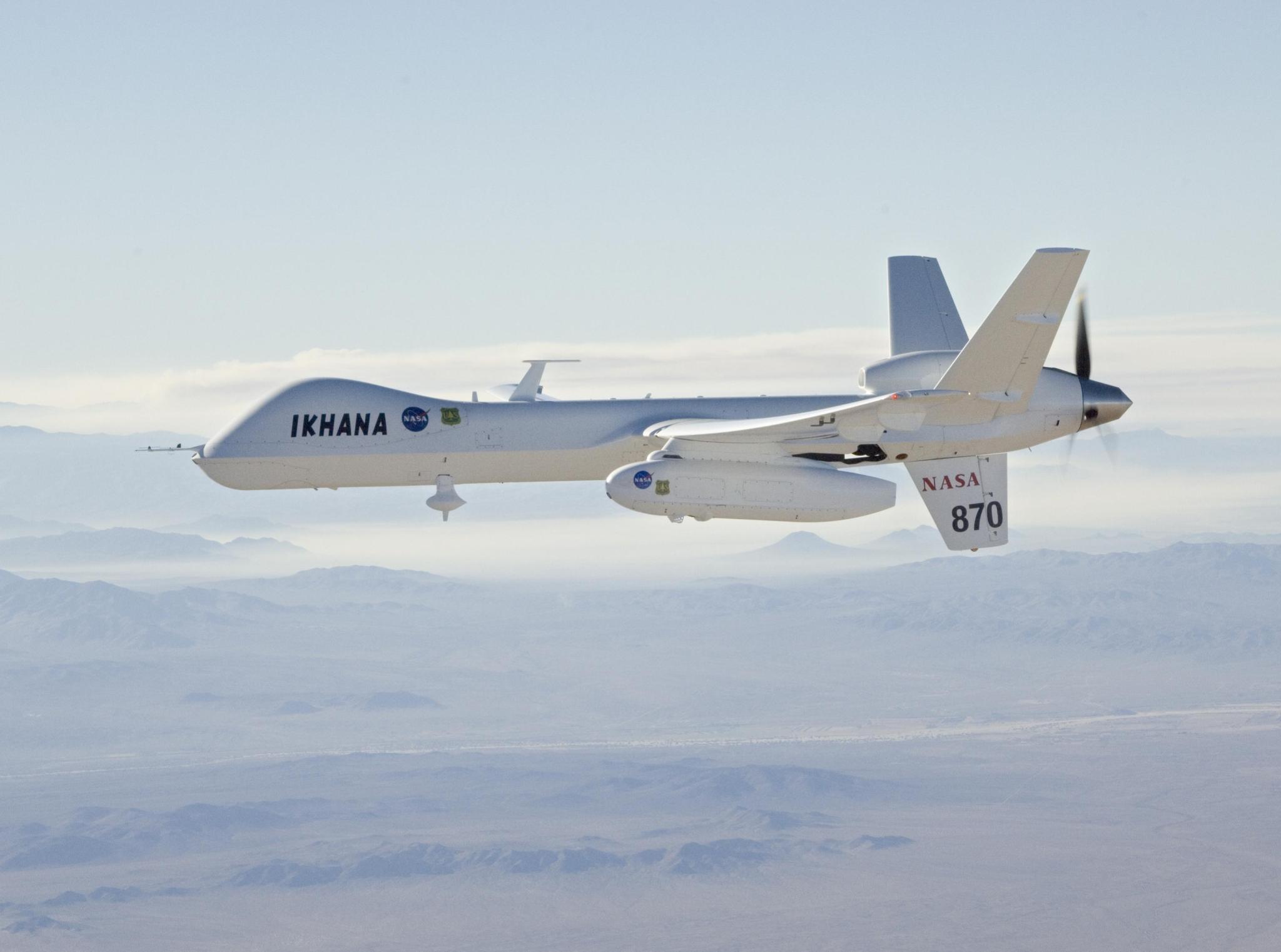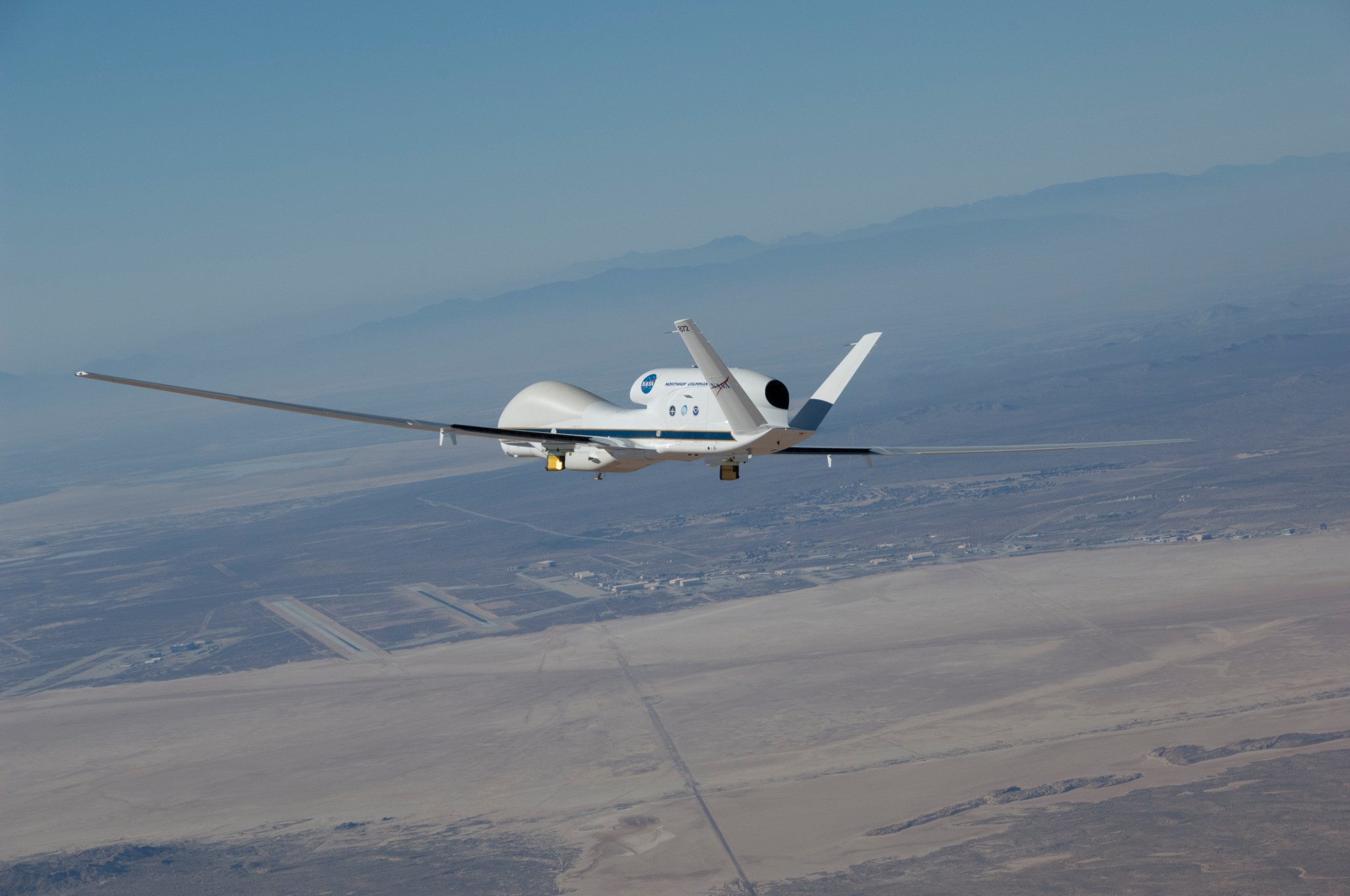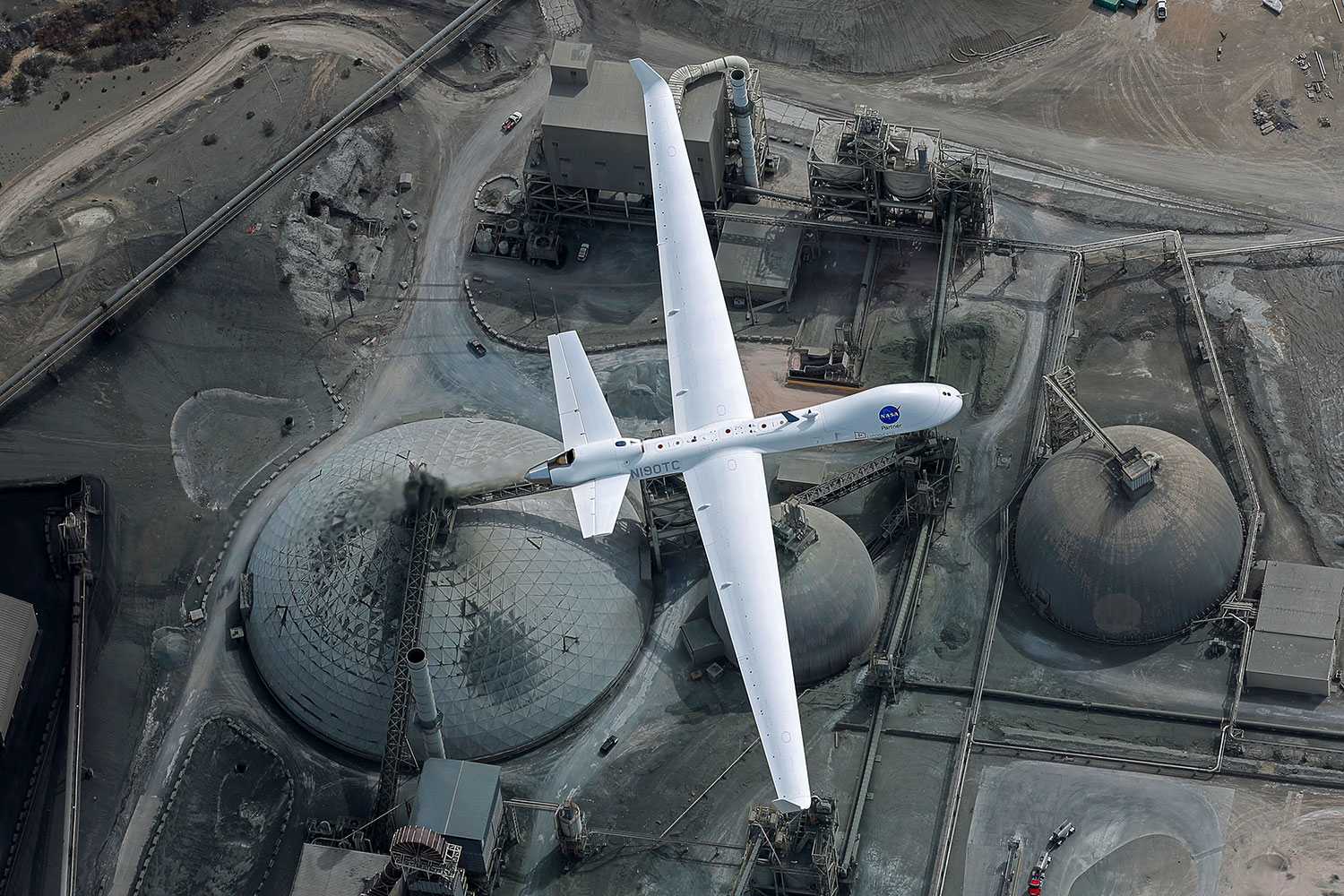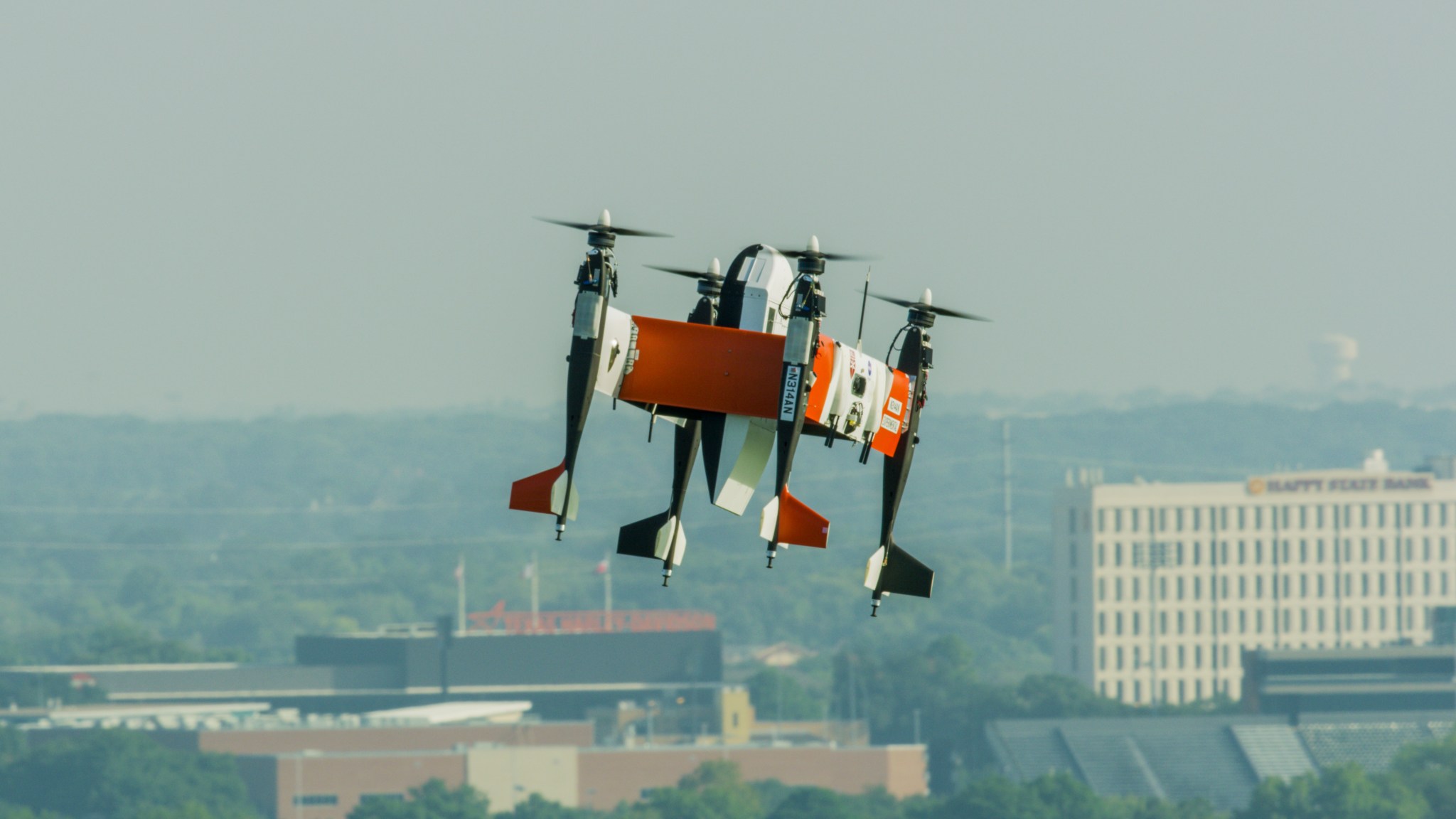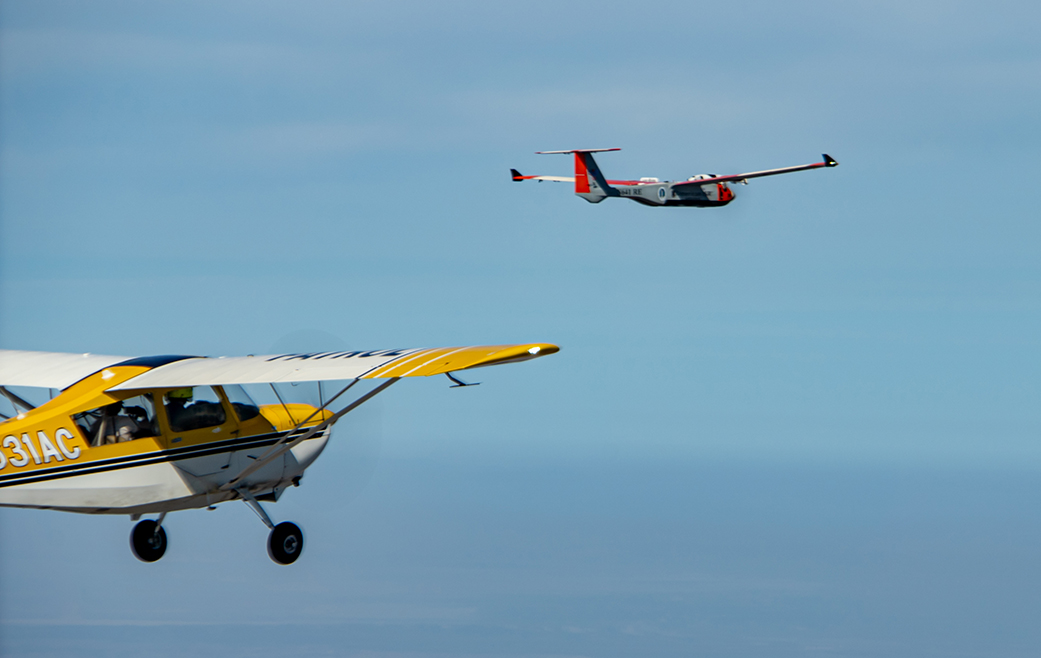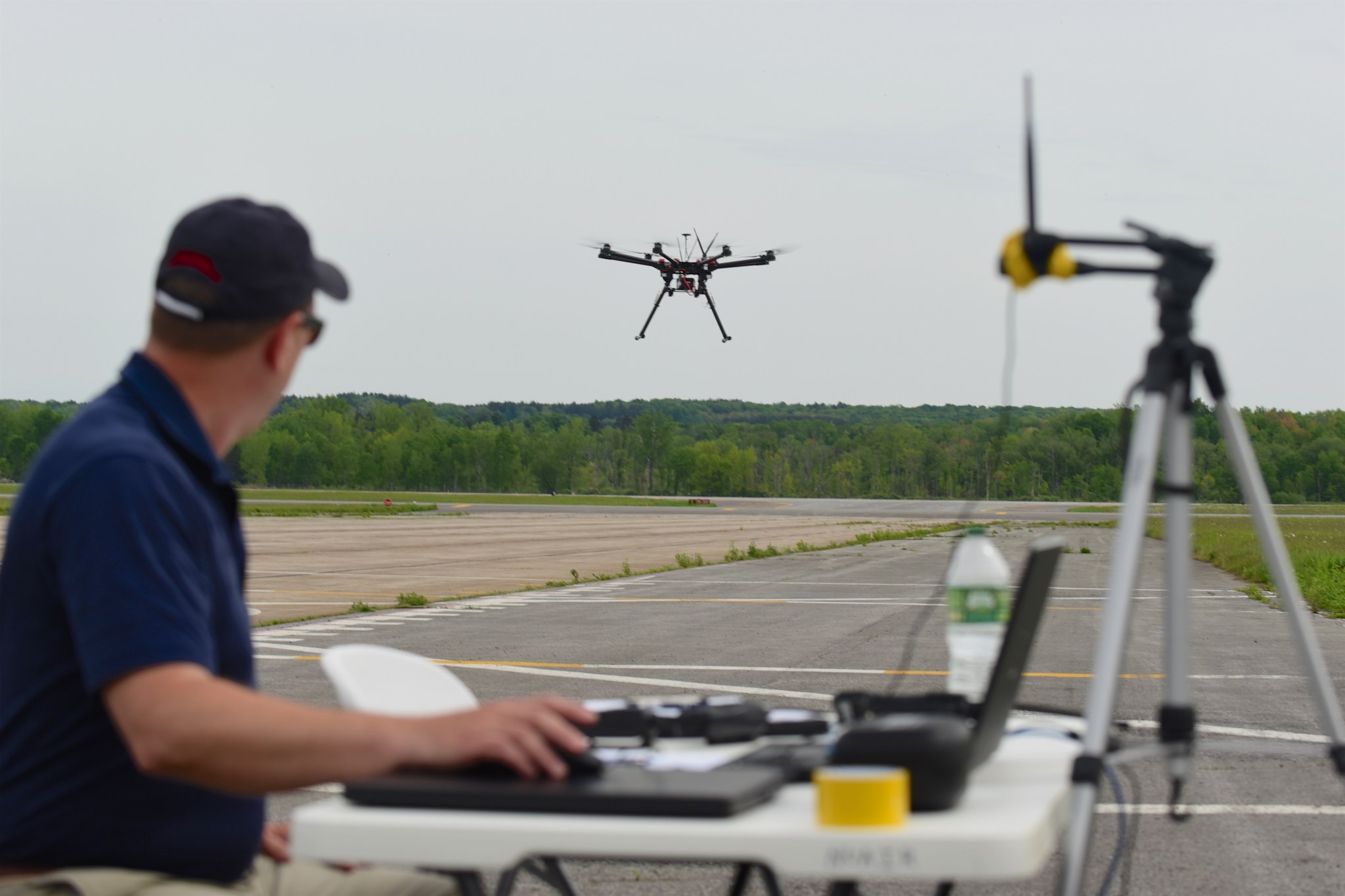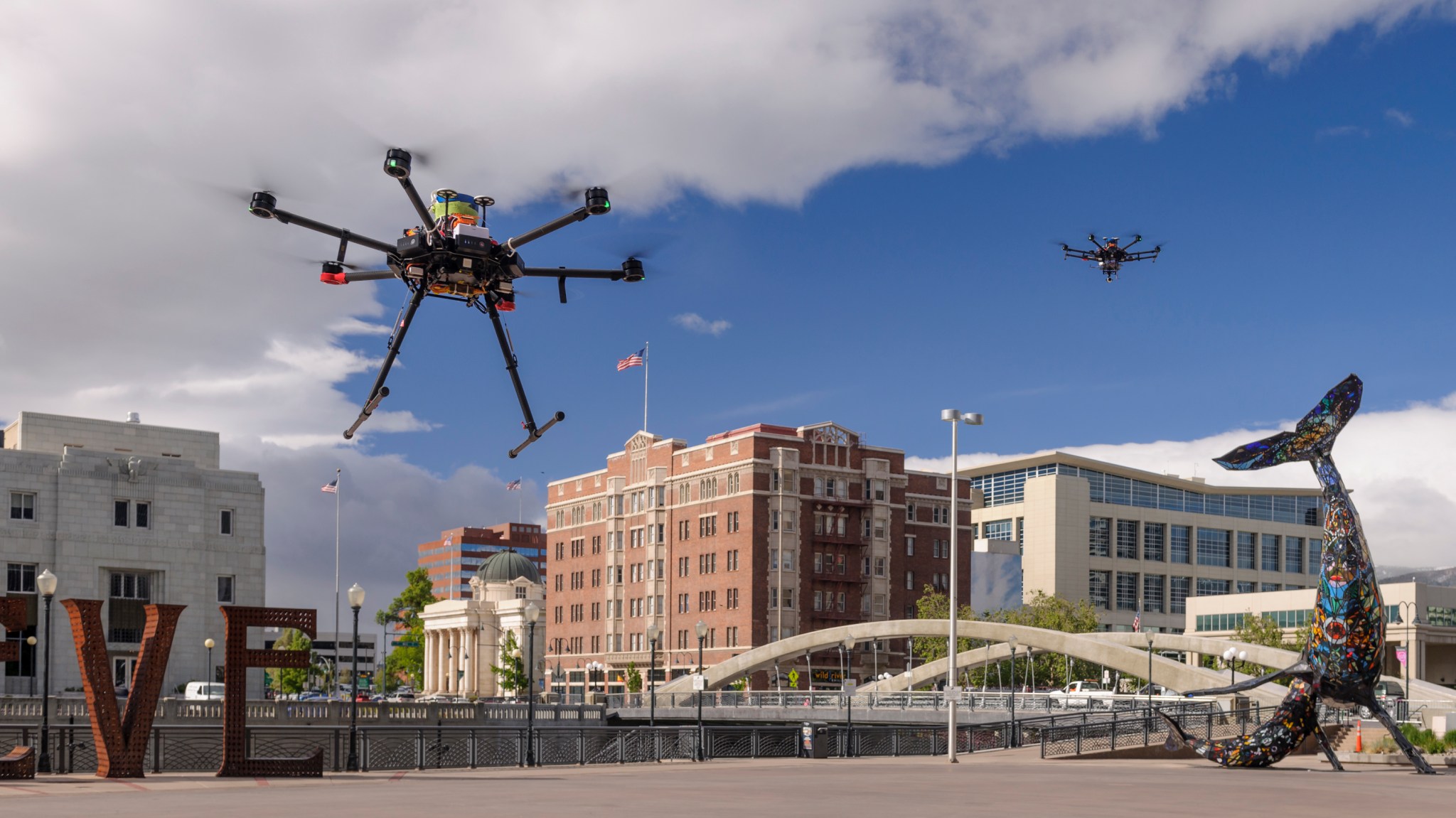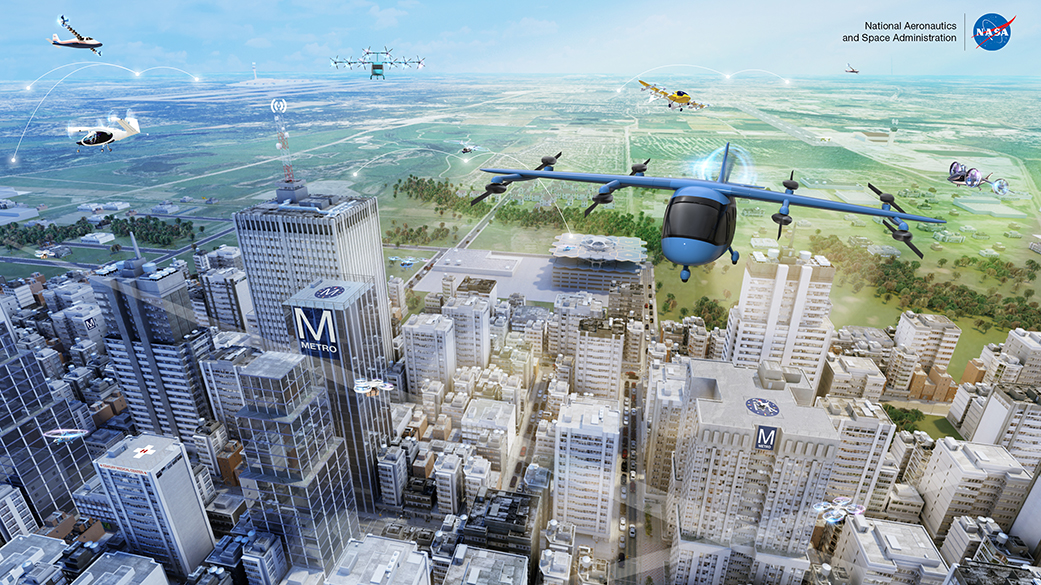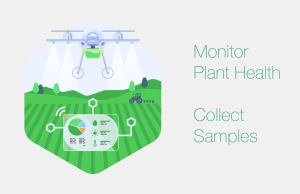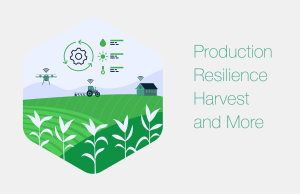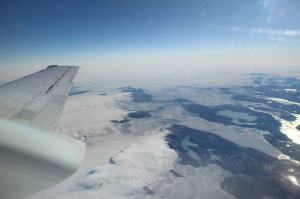In this essay from 2021 — which was originally presented as a three-part web feature — NASA Aeronautics’ senior writer Jim Banke tells his newborn grandson, Axel, the story about how two recently concluded major air traffic management research projects will help achieve a long-held vision for the future of aviation.
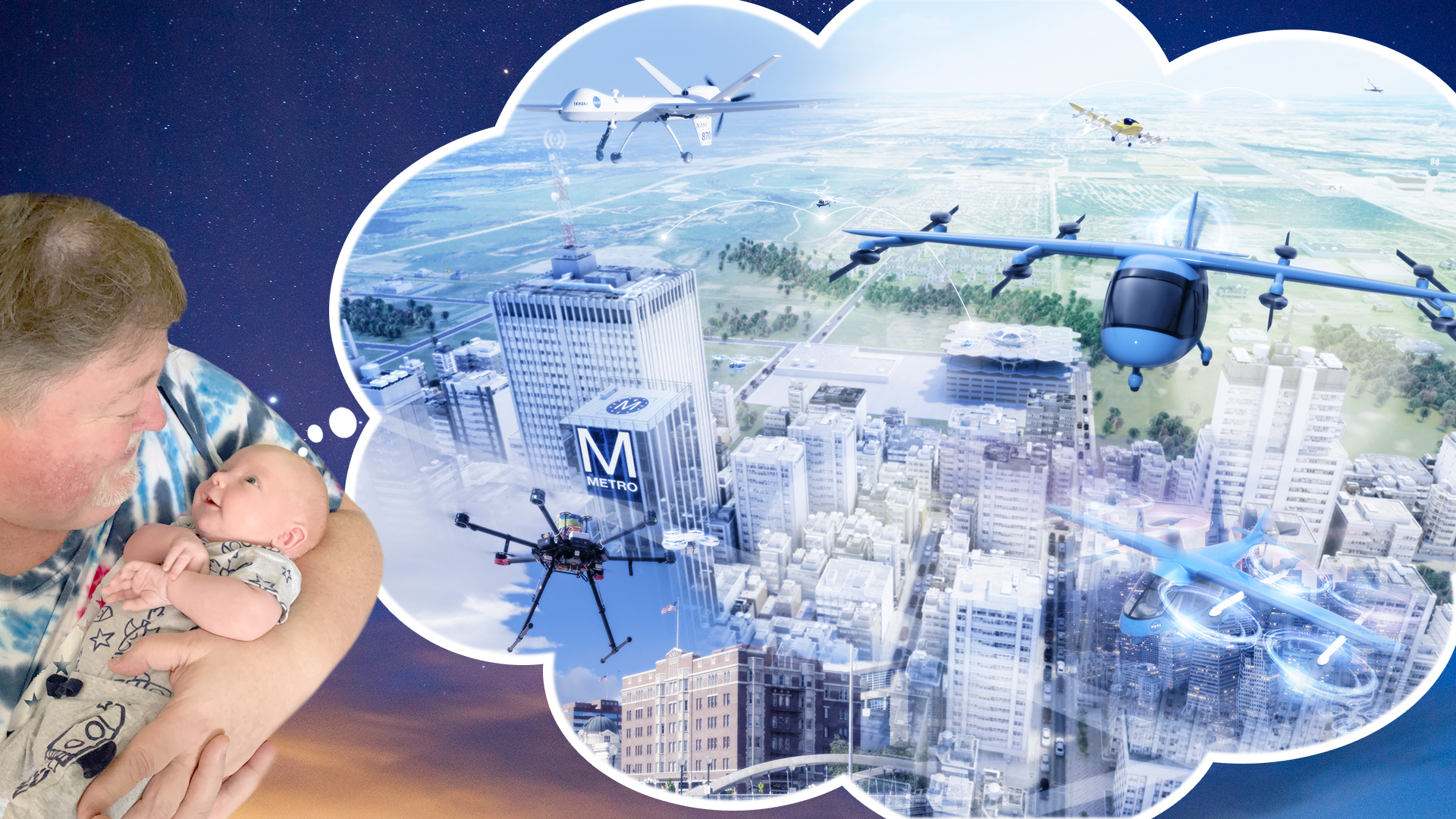
Well, Axel, it’s just you and me.
Everyone else in the house is asleep, although that wasn’t the case an hour ago. For a baby barely six months old, you sure can make a racket when you’re hungry. Now you’re fed, burped, and stubbornly refusing to go back to sleep.
As much I would love to quietly hold you all night, basking in the aura of that special flavor of love that only grandparents know, I know that we both need our sleep. I suppose I could sing you a lullaby, but I want you to grow up with fond memories of me.
So, a story about the future it is, which we will begin by looking to the past. Ready?
A long time ago, when your grandpa was just a kid growing up in Minnesota, one of my favorite TV shows was “The Jetsons.”
This animated classic from the 1960s – which I will be sure to show you when you’re a little older – imagined families who live in a world where the skies were filled with flying cars. A single push of a button automatically took them shopping, to work, or to visit friends or family.
These same gravity-defying flying vehicles could take you to other cities at supersonic speeds. Larger vehicles could even be seen leaving the atmosphere for a journey to the Moon or a nearby planet.
All of it looked safe, clean, fun, and futuristic – and the flying cars made these cool tuneful puffs of air sound when they flew. We all expected it to happen in our lifetimes. And now it looks like it really will in your lifetime – and maybe soon enough for mine.
When it does, when you’re able to call for an air taxi to take you to work or order a pizza delivered by drone, I hope you’ll remember this story I’m going to tell you now about the two NASA aeronautics projects that helped make it all possible.
For the first act in the story, we need to go back about 10 years – just about the time your dad graduated from college. This is when a new breed of airplanes remotely flown by pilots on the ground began to make their mark in the world.
The Beginning: UAS in the NAS Project
Initially these drones – as they were generally known then and now – were associated with the military. An Air Force pilot or Naval aviator could safely sit in a control room in the United States while flying a drone on a critical mission overseas.
As more and more of these missions were flown and made public, civilian and commercial organizations looked on with interest. They thought hard about how these Unmanned Aircraft Systems, or UAS, could be used by them back home.
By the way, at this point we’re not talking about the smaller quadcopter drones that people were beginning to play with in their backyard. Or even the radio-controlled hobby airplanes your Great Uncle Bob is fond of building and flying at the park.
Instead, these UAS aircraft – which some people also call Unmanned Aerial Vehicles, or UAV’s, so don’t be confused by that – were large drones designed to fly at high altitudes for a long time. They had names such as Predator B, Global Hawk, and Ikhana.
Ideas for their non-military use included aerial photography to help with planning the layout of a city. First responders could get a bird’s-eye view of a large fire. Utility companies could use them to more easily inspect isolated powerlines. Scientists could gather climate data from distant locations.
But for both commercial and military users there was one major obstacle to overcome.
Someone had to prove to the Federal Aviation Administration (FAA) it was safe to allow remotely piloted UAS access to the National Airspace System, or NAS, where commercial airliners routinely fly.
This idea was something new to aviation, a community known for moving cautiously before embracing change to protect its unrivaled record of safety. There were a lot of questions about UAS operations that had to be answered first.
It was immediately clear that allowing UAS to fly in the NAS would require the FAA to adopt new rules that laid out exactly how all this should work. These rules would be based on new standards and operating procedures that had yet to be determined.
NASA Gets Involved
Enter NASA, where the first “A” stands for Aeronautics, the study of all things related to flight.
Encouraged by a bunch of different people and organizations, NASA in 2011 began the UAS Integration in the NAS project to lead the aviation community, relevant government agencies, and others in conducting the research needed to draft those standards and procedures.
Spoiler alert, Axel: The whole thing was a success.
“This really was a big deal. We have now contributed to setting standards and requirements of what UAS must meet to safely operate in the national airspace. That didn’t exist a decade ago.”

Mauricio Rivas
Project Manager
My friend Mauricio Rivas managed this project, and this is what he told me about what they accomplished:
“This really was a big deal. We have now contributed to setting standards and requirements of what UAS must meet to safely operate in the national airspace. That didn’t exist a decade ago.”
Here’s how that happened.
Unlike most other research projects, NASA didn’t need to invent or develop any new gadget. Industry would design and build the UAS aircraft and electronic systems. Then NASA would help demonstrate how that technology could safely fly in the NAS.
To do this, NASA worked with the FAA to create a flight test environment that used real and simulated situations. That way industry could, through a series of real flight tests, prove that any new technologies or procedures would work as predicted.
The results of this series of flight tests provided information needed for writing new Minimum Operational Performance Standards, or MOPS, for the FAA to consider officially adopting – which was the reason for the UAS in the NAS project in the first place.
So, Axel, you’ve had a peek at the end of this particular project, but there’s still more to tell about how we got there – including how the UAS in the NAS project made aviation history by flying a… well, stay tuned.
Part Two
Wow, Axel, about a third of the way into the story about work recently done by NASA’s aeronautical innovators and you’re still wide awake and smiling at me. I take this as a good sign you’re enjoying the story and love airplanes as much as I do.
To fully appreciate this part of the story, it would be helpful here to tell you about the two key technical areas that were an important part of the research in the Unmanned Aircraft Systems in the National Airspace System (UAS in the NAS) and the UAS Traffic Management (UTM) projects.
First up is Detect and Avoid, or DAA. This has to do with an aircraft’s ability to sense when it is about to find itself dangerously close to another object (detect), and then do something appropriate to make things safe (avoid).
As an example, this might mean an onboard radar sees another airplane, determines the two aircraft are about to fly too close to each other, or even collide, and then sounds an alert to signal the remote pilot to change course or respond in some way.
The second technical area is Command and Control, or C2. This has to do with making sure the remote pilot always has a secure and solid radio link with the aircraft. It’s that link that allows the pilot to send commands to maintain control of, and receive data back, from the drone.
“Secure and solid” in this case meant proving an aircraft’s radios couldn’t be jammed by bad guys or an accident – or that weather or topography wouldn’t affect the quality of the radio signal, and enough of the best frequencies were available to use.
Again, it wasn’t NASA’s job to invent the hardware that could do all these things. But it was our job to help put this hardware through the wringer and use the resulting information to come up with a proposed set of Minimum Operational Performance Standards (MOPS) mentioned earlier in our story.
Phased Approach
Ultimately the UAS in the NAS project completed its work in two phases.
Phase 1 began in 2011 and primarily looked at drones operating at altitudes of 18,000 feet and higher. Airplanes at this height are in constant contact with air traffic controllers, must file flight plans, and follow long-established rules when in this airspace.
Phase 2 began in 2016 and considered drone operations in the altitude range of 500 feet to 10,000 feet high. Airplanes in this airspace are more likely to be General Aviation aircraft, many of which don’t need to file flight plans or interact with air traffic control.
Remember Mauricio Rivas, my friend who managed the UAS in the NAS project?
He told me this made writing a MOPS for this airspace a bit more challenging. With more aircraft of so many different types flying in this airspace without someone always directing the traffic, the MOPS had more scenarios to account for to avoid potential trouble.
Just like every college course ends with a final exam – something, Axel, I expect you will experience in about 18 years or so – each of these UAS in the NAS phases ended with a big test.
A 'Solo' Flight
For Phase 1 the final test happened in June of 2018 and resulted in making aviation history.
The whole point of the UAS in the NAS project was to enable these larger, remotely piloted drones to make a flight just like any other piloted airplane flying in commercial airspace. The final test for Phase 1 saw that very thing happen.
What was unique and history making was the fact that the drone – NASA’s Ikhana UAS in this case – made the flight without a piloted aircraft flying nearby to keep an eye on it. All previous flight tests were required by FAA rules to have this “chase” plane.
Granted a waiver by the FAA under the condition the flight be made following all the standards developed during the Phase 1 flight tests, Ikhana took off without a chase plane from Edwards Air Force Base in California.
It flew in commercial airspace to other points within the state and then returned to Edwards. During the flight, air traffic controllers talked to the remote pilot as though the pilot was on the airplane.
The controllers later said the flight sounded and looked on their displays like any other flight.
And since that was the whole point – success!
This was a really significant achievement, not just because it was a cool thing to do, but it was historic.

Lee Noble
Program Director
“They didn’t have any idea the pilot was on the ground. This was a really significant achievement, not just because it was a cool thing to do, but it was historic. The fact that the controllers didn’t know it was unmanned, that was just icing on the cake.”
That’s what Lee Noble said to me about the flight. He’s director of the Integrated Aviation Systems Program, which is the program that oversaw the UAS in the NAS project.
Concept Demonstrated
The finals for Phase 2 weren’t historic to the same extent, but Lee said they were just as significant.
For this final part of the project, which took place in 2020, two companies partnered with NASA to participate in what was called a Systems Integration and Operationalization Demonstration Activity, or SIO. A mouthful, Axel, I know, but easy to understand.
The basic idea was for each company to take all they had learned so far about DAA and C2 and demonstrate the ability to fly its drone on a specific mission that would be an example of a possible future use for a commercial UAS flight within the NAS.
The first SIO flight was in April 2020. General Atomic Aeronautical Systems flew its SkyGuardian UAS over southern California on an infrastructure inspection mission from 10,000 feet high.
The second SIO flight was in September 2020, less than two weeks after you were born. Bell Textron flew its APT 70 UAS near Fort Worth, Texas on a simulated urgent medical transport mission.
In both cases the remote pilots had to interact with air traffic controllers as they navigated flying through busy airspace. And in both cases these final exams of Phase 2 were given passing marks.
Here’s how Lee explained the importance of the SIO’s:
“Beyond the SIO flights themselves, the idea was to coordinate with our partners and the FAA as they worked through the process that would lead to certifying these systems. The partners learned some things about what was important to the FAA, and the FAA learned some things about how the partners viewed the process and what they struggled with along the way.”
Incidentally, a third company, American Aerospace Technologies, was planning to conduct a third SIO before the UAS in the NAS project officially ended last year, but various issues delayed it into 2021.
Like the first two SIO demonstrations, the third one was a success too.
So that was the UAS in the NAS project: Making it possible for remotely piloted medium to big drones to safely fly among other airplanes in airspace from 500 feet up all the way to the top of the flyable atmosphere – and all while staying in touch with air traffic managers everywhere.
Mauricio wrapped it all up this way:
“Of course, this will all change as technology improves, applications change, and we gain more experience. But getting that initial set of standards to the FAA so others can come along and use them to fly for these commercial purposes… This is going to open up new industries for the country.”
But what about small drones flying closer to the ground, below the altitudes covered by the UAS in the NAS project? It took a “crazy” idea revealed in a 2013 YouTube video to get at least one NASA engineer thinking about it.
And his idea might change aviation forever.
Part 3
Axel, it’s time to start wrapping up my story about NASA’s aeronautical innovators and their trailblazing research. Although you’re still wide awake, it’s getting late, and your parents are going to get mad at me if I don’t get you back in your crib soon.
So now we flash back to late 2013, two years after the Unmanned Aircraft Systems in the National Airspace System (UAS in the NAS) project, had started.
It’s just after Thanksgiving and Amazon releases a video on YouTube that reveals its plans to soon use small drones to deliver packages to people’s doorstep.
“That took everybody like… whoa, that is crazy!”
That’s how Parimal Kopardekar, or “PK,” described how he heard the aviation community reacting to the idea of a company with no aviation experience planning to introduce a brand-new air transportation system to the world. And to do it fast.
Today PK is director of the NASA Aeronautical Research Institute, but back then he was a project manager within the Airspace Operations and Safety Program, which was, and still is, home to NASA’s air traffic management systems research.
PK found his thoughts nearly taken over by visions of solving how hundreds of these small drones could make thousands of flights every day over major city areas – like Amazon proposed – and do it safely.
There were so many unknowns: How do you manage all those drones flying low over a city? How do you keep them from colliding with buildings or each other? How would you handle emergency situations, especially if the pilots can’t see the drones they are flying?
PK knew there was no way the Federal Aviation Administration (FAA) – or any other air navigation service provider in the world – could deal with this volume the same way it’s done today. You couldn’t hire and equip enough controllers without making the system collapse beneath its own weight.
Challenge Accepted
But PK was sure he had the answer. It would be called the UAS Traffic Management system, or UTM, and he had refined his thoughts enough to write and file a patent.
Spoiler alert: The patent – officially called “Unmanned Aerial System Traffic Management to Enable Civilian Low Altitude Goods and Service Delivery by UAS” – was granted in 2019, and in 2020 was awarded the Government Invention of the Year.
That should tell you how successful the project was during its five years.
The basic idea behind UTM was to provide an automated network that would manage flights of drones below 400 feet.
Drone operators would tell the UTM system where they wanted to fly, and the system would check to make sure the plan was safe and there would be no conflicts with other scheduled traffic.
It involved a lot of automation and a lot of different systems electronically talking to each other with minimal human involvement. Drone operators could schedule deliveries using a website or even an app.
This would be very different from the way the current system works where pilots who are required to stay in contact with air traffic controllers must get permission every time they want to change their course or altitude.
In its place, information about where every aircraft is in the sky at any time would be digitally communicated across the UTM system, creating what PK called a “share and care environment.”
Companies certified by the FAA would use this network to supply air traffic management services. Instead of a management by permission philosophy, UTM would feature a management by exception mindset. Pilots would only be told what not to do.
Understandably, the FAA was hesitant to embrace the concepts behind UTM at first. Aviation is the safest method of travel for a reason. Change must happen only after every effort is made to ensure safety won’t be affected, and that can take time.
Growing Interest in Drones
To test the waters, PK conducted a small workshop in 2014 with representatives from industry – Google, Amazon, and others – to talk about his ideas. Industry’s positive response gave NASA the confidence to take the next step.
In 2015 NASA officially began the UTM project with PK as its first manager. To help kick things off, the project hosted a three-day conference open to anyone interested in this new area of drone operations.
A few hundred were expected. More than 1,200 people showed up. The fact that attendance at that UTM convention was so huge sent a loud and clear signal to all concerned about the future. This was a big deal.
That “Jetsons” future I dreamed of seemed more possible than ever.
Industry was on board and anxious to get started. The FAA also realized something big was happening. NASA was in an ideal position to lead and serve as a facilitator of sorts as new standards and procedures were developed for UTM and did so.
PK explained the situation to me like this:
“One of the things I liked to say was we were too fast for the FAA and too slow for industry. But after that 2015 workshop, things radically changed. Everybody started to accept it. UTM was the best way to safely accommodate small drones.”
Axel, remember all those acronyms from earlier in the story? DAA, C2, and MOPS? Well in its own way, the UTM project had to work through the same concerns related to DAA and C2 the UAS in the NAS project studied.
And like before, these new MOPS written for the smaller drones at lower altitudes would be sent on to the FAA to consider for adoption.
The challenge: UTM participants couldn’t use the same DAA and C2 equipment developed for the UAS in the NAS because they were too big and too heavy. UTM’s smaller drones – with their size, weight, and power limitations – required a fresh look at how to safely deal with those concerns.
Capable Technology
To test technologies needed for UTM, NASA conducted a series of four increasingly complex field demonstrations between 2015 and 2019. They were known as Technical Capability Levels, or TCL.
TCL-1 kept things very basic. Each drone had its own pilot, who kept the drone in sight as it flew within a controlled test site. How these small drones might be used in firefighting or surveying farmland was demonstrated.
TCL-2 saw drones flying over sparsely populated areas beyond where its pilots could see them. Technologies that enabled the drones to react to changing conditions or emergencies, such as the loss of a radio link between the pilot and drone, were tested.
TCL-3 saw coordinated test flights of drones at six different locations across the country. Here the emphasis was on maintaining safe distances from other aircraft, whether they were part of the test or not.
TCL-4 was the UTM project’s big finish, its final exam.
For this activity, several drones were flown using UTM-related technologies and procedures over areas of larger cities, namely Reno, Nevada, and Corpus Christi, Texas. Package delivery and emergency response were among the tasks demonstrated.
Altogether, NASA brought together and collaborated with more than 100 representatives of industry, academia, and public agency partners – with the FAA at the top of the list. Together, they showed that a highly automated air traffic management system for drones that doesn’t rely on human air traffic controllers could safely work.
PK said the project owes its success to those partnerships.
Finishing the Story
Dreams to Reality
Axel, I can’t stress enough how important the work done by both projects will be to those who are continuing to conduct research to enable this future of aviation that reminds me of the Jetsons – what we call Advanced Air Mobility, or AAM.
In talking with PK, Lee, and others who worked on these projects, the common conclusion they share is that there’d be an even bigger use for the idea that became UTM – and that’s AAM.
AAM is a solution NASA and its partners are working on to safely manage all aircraft sizes flying at every altitude, not just small drones flying below 400 feet.
Based on what was developed for UTM, a system of service suppliers will digitally connect everyone, so every flight knows where it is in relation to nearby flights and when it is safe to fly.
Doing it that way might be the only solution as demand for air travel increases and air traffic control functions become more automated, all of which will expand the amount of digital data exchanged between the ground and the cockpit.
Ron Johnson, the UTM project manager when it ended, told me the UTM system has shown it can be grown along with the growth in air traffic. It might not look the same in the future, but something very much like it is the answer to eventually replacing the current system.
We still have a way to go to realize the full vision of flying cars taking you to work each day, or having a pizza delivered by drone. But the technology and the rules needed to enable those possibilities are beginning to take shape.
We’ve already seen the FAA host its own UTM-related demonstration activities, as well as take some of the standards and procedures written for them to consider and officially turn them into new capabilities offered to the drone community.
The prime example of this is LAANC, the Low Altitude Authorization and Notification Capability – something the FAA describes as a collaboration between the FAA and industry that directly supports UAS integration into the airspace.
LAANC basically works just as the UTM project envisioned and demonstrated through its TCL’s. An operator wishing to fly their small drone below 400 feet in controlled airspace around an airport can get authorization to fly by connecting to LAANC through an official UAS Service Supplier, or USS.
Ron told me LAANC is a very basic first step toward a more capable and comprehensive UTM system of the future. He also said the UTM concept is being embraced by nations around the world, from Austria to New Zealand, allowing US companies to compete on a global basis providing UTM services.
The FAA also has drafted, with NASA’s help, a concept of operations for using a UTM system for aircraft flying above 60,000 feet – higher than today’s commercial airliners fly – but it is not operational yet.
As cool as all that is, it’s only the start.
There’s still plenty of work to do, plenty of learning to be done. It will involve a lot of good people within NASA and among its many partners and collaborators who care about your future. And everyone else’s too.
It won’t be long until you’re old enough to have pizza, so here’s a promise. The first one delivered to your house by drone is on me. Yes, we can make it half and half – half pepperoni for you (like your sister, Evelyn, likes it), half sausage and sauerkraut for me.
And that’s the end of the story. For now.
Now it’s time to close your eyes and go to sleep, Axel. Sweet dreams of the future of flight. I love you.



























